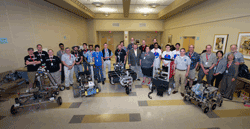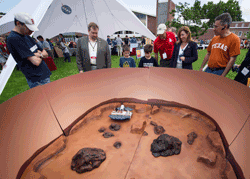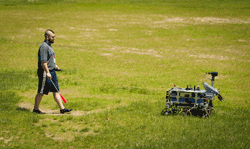And this year’s NASA Sample Return Robot Challenge winner is…
No one.
BY NICOLETTE EMMINO
Six robots geared up at the Worcester Polytechnic Institute in Worcester, MA from June 14 to June 17 to participate in NASA’s Sample Return Robot Challenge for a prize of $ 1.5 million.
Initially, eleven teams were registered to compete, but after careful weigh-ins and inspections, only six made it to the starting line of this scavenger-like competition. The challenge objective is for a robot to explore various terrains autonomously and be able to collect samples from the given grounds. The winners would help spark further technological advances such that one day we could launch autonomous robots to different worlds where they can collect different planetary samples.

Teams from across the country brought their robots to participate. (Via NASA)
The primary purpose of the competition is space exploration, but can also be used to benefit technologies here on earth for use in disaster recovery, as well as exploration of hazardous areas.
The contestants gathered and the robots went off to explore the various terrains such as rolling lands, rocks, secure obstacles, and aquatic territories with no GPS or human control.
While the competition was underway, families gathered to participate in the Worcester Polytechnic Institute’s “Touch Tomorrow” festival, where they offered hands on activities and exhibits for guests. Exhibits included a virtual space station, slime-making, and a vacuum chamber.

Interactive NASA Mars exhibit, part of the Touch Tomorrow festival. (Via NASA)
In the first part of the competition, the teams compete for lower cash prizes, where their robots navigate terrains to retrieve hidden samples.
The hunt is organized by a point system in which awards are given based not only on the points acquired, but also the number of successful robots. Judges are not as focused on the robot as much as they are the results the robot can produce and how they can advance technology. Therefore, a robot must meet all requirements to be awarded a cash prize.
The second round is a bit more challenging, asking participants to hunt for samples over more complex landscapes in just two hours. This year, no team advanced to the second round and there were no pronounced winners. These results display the complexity of developing a robot capable of autonomous space exploration. Although there were no winners, the competition did help create momentum in the discovery of such systems.

Robot sets off to collect “planetary samples.” (Via NASA)
The last Centennial Challenge, the Green Flight Challenge, produced two winners totaling a cash prize of $1.6 million for their advancements in aviation speed and fuel efficiency.
So go prep your robots and get ready for NASA’s next Centennial Challenge. ■
Advertisement
Learn more about Electronic Products Magazine





